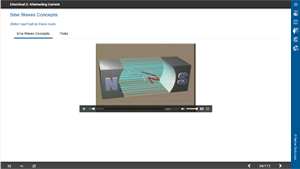Learning Objectives
Explain why voltage rises and falls in an AC circuit.
Determine the voltage values for any theta of an AC sine wave.
Calculate the peak, effective, and root mean square (rms) voltage values for a given AC sine wave.
Identify the phase relationships between two AC waveforms.
Identify leading and lagging waveforms.
Create a vector diagram describing the phase relationships between two AC waveforms.
Describe the phase relationship between voltage and current in a resistive AC circuit.
Calculate the voltage, current, resistance, and power in an AC resistive circuit.
Describe the voltage and current transients that occur in an inductive AC circuit.
Identify factors that can affect the inductive reactance in an AC circuit.
Recognize a vector diagram for an AC inductive circuit.
Calculate the inductive reactance in an AC circuit.
Describe the voltage and current transients that occur in a capacitive AC circuit.
Identify factors that can affect the capacitance of an AC circuit.
Recognize a vector diagram for an AC capacitive circuit.
Calculate the capacitive reactance in an AC circuit.
Describe the voltage and current relationships in circuits that contain resistance, inductance, and capacitance.
Create vector diagrams that describe the impedance of AC circuits that contain resistance, inductance, and capacitance.
Calculate the impedance, voltage, and current through AC circuits that contain resistance, inductance, and capacitance.
Describe the effect of resonant frequencies in series and parallel circuits.
Describe how bandwidth is affected by resistance in series and parallel circuits.
Describe the relationship between true power, apparent power, and reactive power in an AC circuit.
Calculate the true power, apparent power, reactive power, and power factor of an AC circuit.
Determine whether the power factor of a circuit is leading or lagging.












